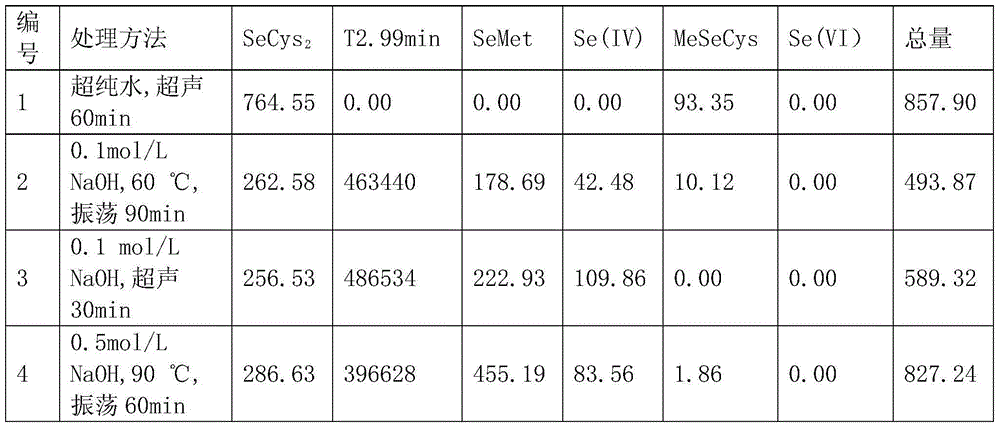Method for extracting selenocystine and selenomethionine from selenium-gathered plant Cardamine hirsuta
A technology of selenocystine and selenomethionine, which is applied in food science, metabolic diseases, drug combination, etc., can solve problems such as waste of resources, and achieve the effects of high product extraction rate, simple technical process, and wide application
- Summary
- Abstract
- Description
- Claims
- Application Information
AI Technical Summary
Problems solved by technology
Method used
Image
Examples
Embodiment 1
[0051] The present invention is a method for extracting selenocystine and selenomethionine from the polyselenium plant Cardamine. The specific steps are as follows: weigh 10g of a sample of Cardamine with a selenium content of 2158.97 mg / kg, and add 50 mL of ultrapure Water, sonicate for 60min, filter, and extract the filter residue twice with water. Wash the residue, combine the filtrate, and dilute to 200mL. Detected by HPLC-HG-AGS. The chromatographic conditions are: anion exchange column, A mobile phase 40mM, B mobile phase 60mM (Adjust the pH value to 6.0 with formic acid), flow rate 1.0mL / min, use 0min~3min: 100% A; 3min~4min: 100% A→100% B; 4min~10min: 100% B; 10min~12.5min: 100% A gradient elution, retention time of selenocystine is 2.42±0.25min, and the content of selenocystine in the extract is 952.25mg / kg. It is separated by high-pressure preparation system, and the conditions are the same as the above chromatogram. 2. For the solution between 10 and 2.70 minutes, pu...
Embodiment 2
[0053] The present invention is a method for extracting selenocystine and selenomethionine from the polyselenium plant Cardamine. The specific steps are as follows: Weigh 10g of a sample of Cardamine with a selenium content of 2158.97 mg / kg, and add 50mL0.1mol / Shake the L HCl solution for 90 min at 60°C, extract the filter residue twice with water, wash the residue, combine the filtrate, adjust the pH value to 6-7 with NaOH solution, and dilute to 200 mL. Detected by HPLC-HG-AGS. The content of selenocystine is 747.00mg / kg, and the content of selenomethionine is 216.34mg / kg. It is separated by a high-pressure preparation system under the same conditions as the above chromatogram. The selenocystine solution between 2.10 and 2.70 min is collected in sections And the selenomethionine solution between 3.10 and 3.70 minutes, dialyzed, freeze-dried and weighed, respectively 5.35mg and 1.88mg, the purity was 98.4% and 98.8% respectively.
Embodiment 3
[0055] The present invention is a method for extracting selenocystine and selenomethionine from the polyselenium plant Cardamine. The specific steps are as follows: Weigh 10g of a sample of Cardamine with a selenium content of 2158.97 mg / kg, and add 50mL 1mol / L HCl, ultrasonic extraction for 60 minutes, the filter residue was extracted twice, the residue was washed, the filtrate was combined, the pH value was adjusted to 6-7 with NaOH solution, the volume was adjusted to 200 mL, and the selenocystine in the extract was detected by HPLC-HG-AGS The content is 763.56 mg / kg, and the content of selenomethionine is 223.16 mg / kg. It is separated by a high-pressure preparation system under the same conditions as the above chromatography. The selenocystine solution and selenomethionine solution are collected in sections, and weighed after dialysis and freeze drying. The weight is 6.18mg and 1.95mg, and the purity is 98.5% and 98.6%.
PUM
 Login to View More
Login to View More Abstract
Description
Claims
Application Information
 Login to View More
Login to View More - R&D
- Intellectual Property
- Life Sciences
- Materials
- Tech Scout
- Unparalleled Data Quality
- Higher Quality Content
- 60% Fewer Hallucinations
Browse by: Latest US Patents, China's latest patents, Technical Efficacy Thesaurus, Application Domain, Technology Topic, Popular Technical Reports.
© 2025 PatSnap. All rights reserved.Legal|Privacy policy|Modern Slavery Act Transparency Statement|Sitemap|About US| Contact US: help@patsnap.com


